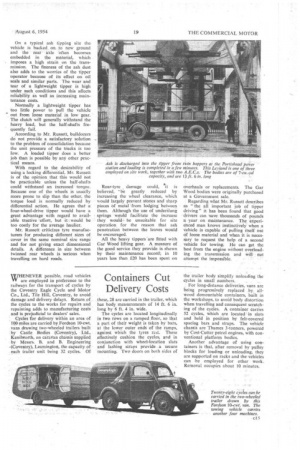Heavy Tippers Best for Work on Sites
Page 52

Page 53

If you've noticed an error in this article please click here to report it so we can fix it.
Why a Bristol Operator Eschews Lightweight Vehicles for his Work in Spite of their Lower First Cost and Annual Taxation : Modest Body Maintenance Expenditure
46E have proved in over 20 years of tipper operations that for heavy site work it pays to purchase 7i-ton machines to carry 6-ton loads rather than the lightweight type of machine. The lower cost of maintenance far outweighs the extra costs of taxation and the higher purchase price, but we are penalized by the low axle weights allowed."
This support for the heavy tipper is given by Mr. Sam Russett, 580 Fishponds Road, Bristol, who operates three A.E.C. Monarchs, two Leyland Beavers and one Leyland Badger on site work, mainly handling ash from power stations. The tippers average 12 m.p.g.
Slip-fit Liners
Other vehicles in the fleet include fry° Thames tippers for road work, three Leyland Beaver platform lorries.
two Leyland Retrievers, which are exW.D. machines, and one Leyland Badger platform vehicle. The engines of the Leylands are fitted with new slipfit liners after the vehicles have covered 80,000 miles, and a distance of 200,000 miles is covered before the crankshaft is reground. The use of slip-fit liners greatly simplifies the intermediate overhauls.
The engines run on Wakefield lubricant with a low degree of detergency, which is considered better than a fully detergent oil in that " it leaves the carbon where it is." Carbon held in suspenSiOn would, it is maintained, score the working surfaces.
During the war, Mr. Russett's fleet of . nine vehicles moved 225,000 tons of material in , the 21 months of the . 14 Mulberry harbour scheme, and practically every type of repair job was undertaken in the workshops, including splitting half shafts and so on.
There was not one case of big-end failure in any of the oil engines. In Mr. Russett's view it is a great mistake to use cheap oil in an engine even when it is badly worn. He disagrees with the policy that the qualities of the oil are less important when the consumption is high.
Anti-freeze is not used in the winter because of possible clogging action on the radiator. During the colder months the fan belts of the Leyland engines are removed to maintain a high working temperature.
The bodies of the heavy tippers are constructed from three Gar Wood bodies which are sectioned and the parts welded together to increase the original length from 10 ft. 8 in. to 13 ft. 6 in. to enable 7 cu. yd. of ash, weighing 6 tons, to be carried. On a typical ash tipping site the vehicle is backed on< to new ground and the rear axle 'often becomes embedded in the material, which . imposes a high strait' on the transmission_ The fineness of the ash dust also adds to the worries of the tipper operator because of its effect on oil sells and similar parts. The wear and tear of a lightweight tipper is high under such conditions and this affects reliability as well as increasing maintenance costs.
Normally a lightweight tipper has too little power to pull the vehicle • out from loose material in low gear. The clutch will generally withstand the heavy load, but the half-shafts frequently fail.
'According to Mr. Russett, bulldozers do not provide a satisfactory Solution to the problem of consolidation because the unit pressure of the tracks is too low. A loaded tipper does a better job than is possible by any other practical means.
With regard to the desirability of using a locking differential, Mr. Russett is of the opinion that this would not be practicable unless the half-shafts could withstand an increased torque. Because one of the wheels is usually more prone to slip than the other, the torque load is normally reduced by differential action. He agrees that a four-wheel-drive tipper would have a great advantage with regard to available trattive effort, but it would be too costly for the average haulier.
Mr. Russett criticizes tyre manufacturers for producing different sizes of cover in the same nominal size range and for not giving exact dimensional details. A difference in size between twinned rear wheels is serious when travelling on hard roads.
Rear-tyrecould, it is believed, be greatly reduced by increasing the wheel clearance, which would largely prevent stones and sharp pieces of metal from locliing between them. Although the use of undersiung springs would facilitate the increase they would; be unsuitable for site operation. for the reason that ash penetration between the leaves would be encouraged.
All the heavy tippers are fitted with Gar Wood lifting gear. A measure of the good service they provide is shown by their maintenance record; in 10 years less than £20 has been spent on overhauls or replacements. The Gar Wood bodies were originally purchased at a Government sale.
Regarding what Mr. Russett describes as "the all important job of tipper driving" it has been found that good drivers can sae thousands of pounds a yeat on maintenance. The experienced man knows instinctivelywhen a vehicle is capable of pulling itself out of loose material and when it is necessary' to request the help of a second vehicle for towing. He can get the best from the engine without overloading the transmission and will not attempt the impossible.




























































































